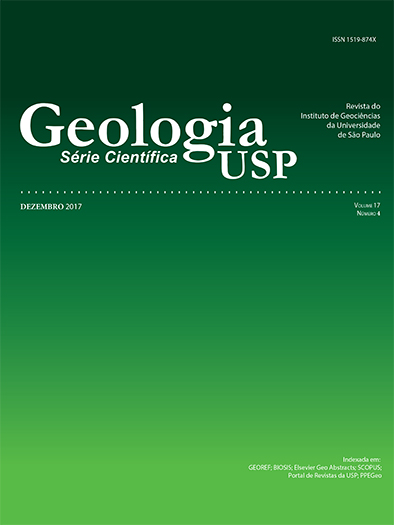Lithogeochemistry and geochronology of the migmatitic orthogneisses from the Itabaiana Dome, Sergipe, Brazil: a typical tonalite–trondhjemite–granodiorite suite?
DOI:
https://doi.org/10.11606/issn.2316-9095.v17-121838Keywords:
Itabaiana Dome, Orthogneisses, Archean TTG, Calc-alkaline normal.Abstract
The Itabaiana Dome is inserted in the Vaza Barris Domain of the Sergipano Belt, in the state of Sergipe, Brazil. It comprises an gneissicmigmatitic complex composed of migmatized orthogneisses, with interbedded amphibolite levels. The set was reworked and uplifted during the Neoproterozoic deformation process this range. Petrographic studies show that the orthogneisses are tonalite to granodiorite composition, with features from the protomylonitics to mylonitic. The lithogeochemistry shows a strong sodic characteristic of these rocks, which were analyzed in two different group, considering their rare-earth elements (REE)’s pattern and K2O content. The lithotypes with the contents of K2O < 2,5% have a term of calcium alkaline series of low K to normal calcium alkaline. However, the ones with content K2O ≥ 2.5% consist in placed terms in the interface of a normal calcium alkaline series, with a high K calcium alkaline series. The two groups pose a negative anomaly of Th-U, Ta-Nb and Ti with low content of Y. They exhibit a strong fractional pattern, with light rare earth enrichment and depletion of heavy rare earths. Only one group shows a positive anomaly of Sr and the spectrum concavity of heavy rare earths, which are typical features of the Archean tonalite–trondhjemite–granodiorite — Archean TTGs. It is suggested that both has affinity with TTGs and the group that is more enriched in K2O received a type of crustal participation in its gneiss. The geochronological analyses determined age of 2729 ± 12 Ma (LA-ICP-MS), which is translated as the age of the rock crystallization of orthogneisses.Downloads
Download data is not yet available.
Downloads
Published
2018-02-20
Issue
Section
Articles
License
Authors who publish in this journal shall comply with the following terms:
- Authors keep their copyright and grant to Geologia USP: Série Científica the right of first publication, with the paper under the Creative Commons BY-NC-SA license (summary of the license: https://creativecommons.org/licenses/by-nc-sa/4.0 | full text of the license: https://creativecommons.org/licenses/by-nc-sa/4.0/legalcode) that allows the non-commercial sharing of the paper and granting the proper copyrights of the first publication in this journal.
- Authors are authorized to take additional contracts separately, for non-exclusive distribution of the version of the paper published in this journal (publish in institutional repository or as a book chapter), granting the proper copyrights of first publication in this journal.
- Authors are allowed and encouraged to publish and distribute their paper online (in institutional repositories or their personal page) at any point before or during the editorial process, since this can generate productive changes as well as increase the impact and citation of the published paper (See The effect of Open Access and downloads on citation impact).
How to Cite
Santiago, R. C. V., Leal, A. B. de M., Marinho, M. M., Argollo, R. M., Barbosa, J. S. F., & Rocha Júnior, E. R. V. (2018). Lithogeochemistry and geochronology of the migmatitic orthogneisses from the Itabaiana Dome, Sergipe, Brazil: a typical tonalite–trondhjemite–granodiorite suite?. Geologia USP. Série Científica, 17(4), 81-98. https://doi.org/10.11606/issn.2316-9095.v17-121838





